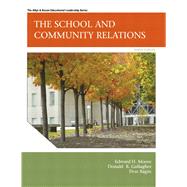
Note: Supplemental materials are not guaranteed with Rental or Used book purchases.
Purchase Benefits
What is included with this book?
Preface
PART ONE Essential Considerations
Chapter 1 The Importance of Public Relations
Why School Public Relations?
Suggestions for Improving Public Confidence
Need for a Communication Plan
Chapter 2 Public Character of the School
Public Character of the School
The Meaning of Public Opinion
School—Community Relations
TraditionalPublic Relations Models
Chapter 3 Understanding the Community
Sociological Inventory
Power Structures
Measuring Public Opinion
Electronic Surveying
Chapter 4 Policies, Goals, and Strategies
Nature of a Policy
Goals and Strategies
Planning Checklist
Chapter 5 Administering the Program
The Board of Education
The Superintendent’s Role
The Administrative Team
Director of School—Community Relations
Standards for Educational Public Relations Professionals
Plans of Organization
Responsibilities of Other Team Members
Budgetary Provisions
Staff Members
General Community Relations Responsibilities
Specific Community Relations Responsibilities
In-Service Training
PART TWO Relations with special Publics
Chapter 6 The Communication Process
Elements of Communication
Communication and Persuasion
Media’s Role in Communication
Words
Crisis Communications
Chapter 7 Communicating with Internal Publics
Why Internal Communications?
School Board Actions
Administration—Employee Relations
Relations among Teachers
Relations with Noninstructional Personnel
Improvement of Staff Relations
Communicating during Negotiations and Strikes
Communicating with Pupils
Instructional Practices
Relations outside the Classroom
The Pupil and Internal Community Relations
Student Unrest
Chapter 8 Communicating with External Publics
The Pupil and External Community Relations
The Teacher’s Communication Role
Importance of Parent Relations
School Liaison Groups
Key Communicators
General Community Groups
Older Adults and the School: An Intergenerational Public Relations Approach
Opportunities for Cooperation
Meeting Criticism and Attacks
Communication during Negotiations and a Strike
Communicating with Diverse Cultures 155
Chapter 9 Crisis Communication
A Crisis Plan Is Essential 159
Crisis Management Teams Are Vital
When a Crisis Strikes: What to Do
Working with the Media
Special Considerations
Prevention: Your First and Best Strategy
Recognizing the Warning Signs
Handling the Aftermath of a Crisis
Chapter 10 Communication about School Services and Special Events
Contacts with the Board of Education or Trustees
Receiving School Visitors
Handling Telephone Calls and Correspondence
Servicing Complaints
Meeting Everyday Contacts
Requests for Information
Participation in Community Life
School Plant Appearance
Special Programs for Older People
Open House
Building Dedications
American Education Week
Business—Industry—Education Cooperation
Community Use of School Facilities
Adult Education
Community Education
PART THREE communication tools
Chapter 11 Working with the Press
Guidelines
The Role of Reporters
The Press and School Board Meetings
The News Conference
What People Want to Know about the Schools
Foreign-Language Newspapers
News Topics in Your Schools
Types of Stories
News Sources
News Organizations
Getting the News to the Press
Mechanics of the News Release
Other Methods
Chapter 12 Radio, Television, Exhibits, and Presentations
Using Radio
Writing for Radio
Working with Radio Personnel
Television Opportunities
Getting Television Time
Planning for Effective Television
School Exhibits
Movies and Videos
Chapter 13 Preparing Online Communications
How New and Old Media Converged in One District
Using Web Sites to Communicate
Chapter 14 Preparing Published Materials
Objectives and School Publications
Knowing the Audience
Choosing Content
Determining Who Should Write the Publications
Knowing How to Publish It
Priorities for Traditional Printing
Designing and Laying Out the Publication
Getting the Most Out of Typography
Using Photos to Enhance Publications
Distributing Printed Publications
Evaluating School Publications
Deciding Which Publications to Print
The Role of Student Publications
Chapter 15 Conducting Special Issue Campaigns
How a Community Accepts a New Idea
The Change Agent
How People Accept Change
Introducing an Innovation
Schools and Marketing Campaigns
A Campaign Example
Chapter 16 Communicating School Finance Issues
What the Research Says
Planning the Campaign
Determining the Proposal
Establishing a Philosophy
Naming a Campaign Director
Timing of the Campaign
Financing the Campaign
Citizens’ Advisory Committee
Other Campaign Participants
Knowing the Community’s Thinking before the Election
Adopting a Theme or Slogan
Personalizing the Campaign
Keep It Simple
Working with the Media
Publications Can Help
Speakers’ Bureau
Endorsements
Small-Group Meetings
Campaign Timetable
Recommendations to Improve Election Day Results
An Example of a Local Campaign
PART FOUR Evaluation
Chapter 17 Assessment and Accountability
Documenting Results
Standards for Evaluation
Supporting Communication Accountability
Tracking Bottom-Line Outputs
Using Research
Why Education Must Be Accountable
Appendix A Organizations that Could Be Helpful
Index
The New copy of this book will include any supplemental materials advertised. Please check the title of the book to determine if it should include any access cards, study guides, lab manuals, CDs, etc.
The Used, Rental and eBook copies of this book are not guaranteed to include any supplemental materials. Typically, only the book itself is included. This is true even if the title states it includes any access cards, study guides, lab manuals, CDs, etc.